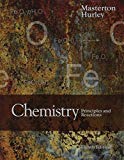
Bundle: Chemistry: Principles and Reactions, 8th, Loose-Leaf + OWLv2, 1 term (6 months) Printed Access Card
8th Edition
ISBN: 9781305717497
Author: William L. Masterton, Cecile N. Hurley
Publisher: Cengage Learning
expand_more
expand_more
format_list_bulleted
Concept explainers
Question
Chapter 19, Problem 14QAP
Interpretation Introduction
Interpretation:
The mass percent of Cl in the sulfate salt of given complex ion is to be calculated.
Concept introduction:
Molar mass is defined as average mass of atoms present in the chemical formula. It is the sum of the atomic masses of all the atoms present in the chemical formula of any compound. Mass percentage of an element in a given complex ion is calculated by dividing the mass of the element present in the given complex ion to the mass of the complex ion.
The formula to calculate mass percent for each element in a given complex ion is as follows:
Expert Solution & Answer
Want to see the full answer?
Check out a sample textbook solution
Students have asked these similar questions
Please help me solve this reaction.
Indicate the products obtained by mixing 2,2-dimethylpropanal with acetaldehyde and sodium ethoxide in ethanol.
Synthesize 2-Ethyl-3-methyloxirane from dimethyl(propyl)sulfonium iodide using the necessary organic or inorganic reagents. Draw the structures of the compounds.
Chapter 19 Solutions
Bundle: Chemistry: Principles and Reactions, 8th, Loose-Leaf + OWLv2, 1 term (6 months) Printed Access Card
Ch. 19 - Prob. 1QAPCh. 19 - Prob. 2QAPCh. 19 - Prob. 3QAPCh. 19 - Platinum(II) forms many complexes, among them...Ch. 19 - Prob. 5QAPCh. 19 - What is the coordination number of the central...Ch. 19 - Prob. 7QAPCh. 19 - Prob. 8QAPCh. 19 - Prob. 9QAPCh. 19 - Prob. 10QAP
Ch. 19 - Prob. 11QAPCh. 19 - Prob. 12QAPCh. 19 - What is the mass percent of sulfur in the...Ch. 19 - Prob. 14QAPCh. 19 - There are four iron atoms in each hemoglobin...Ch. 19 - Vitamin B12 is a coordination compound with cobalt...Ch. 19 - Prob. 17QAPCh. 19 - Prob. 18QAPCh. 19 - Name the following ions or compounds (a)...Ch. 19 - Name the following ions or compounds (a)...Ch. 19 - Prob. 21QAPCh. 19 - Prob. 22QAPCh. 19 - Sketch the geometry of (a)...Ch. 19 - Sketch the geometry of (a) tans-[Cu(Br)2(H2O)4]...Ch. 19 - Prob. 25QAPCh. 19 - Prob. 26QAPCh. 19 - Which of the following octahedral complexes show...Ch. 19 - Prob. 28QAPCh. 19 - Prob. 29QAPCh. 19 - Prob. 30QAPCh. 19 - Prob. 31QAPCh. 19 - Prob. 32QAPCh. 19 - Write an abbreviated orbital diagram and determine...Ch. 19 - Prob. 34QAPCh. 19 - Give the electron distribution in low-spin and/or...Ch. 19 - Prob. 36QAPCh. 19 - Prob. 37QAPCh. 19 - Prob. 38QAPCh. 19 - Prob. 39QAPCh. 19 - Prob. 40QAPCh. 19 - Give the number of unpaired electrons in...Ch. 19 - Prob. 42QAPCh. 19 - Ti(NH3)63+ has a d-orbital electron transition at...Ch. 19 - has a crystal field splitting energy, o, of...Ch. 19 - Prob. 45QAPCh. 19 - Prob. 46QAPCh. 19 - Prob. 47QAPCh. 19 - Prob. 48QAPCh. 19 - Prob. 49QAPCh. 19 - Indicate whether each of the following is true or...Ch. 19 - A child eats 10.0 g of paint containing 5.0% Pb....Ch. 19 - A certain coordination compound has the simplest...Ch. 19 - Prob. 53QAPCh. 19 - In the [Ti(H2O)63+] ion, the splitting between the...
Knowledge Booster
Learn more about
Need a deep-dive on the concept behind this application? Look no further. Learn more about this topic, chemistry and related others by exploring similar questions and additional content below.Similar questions
- Synthesize 2-Hydroxy-2-phenylacetonitrile from phenylmethanol using the necessary organic or inorganic reagents. Draw the structures of the compounds.arrow_forwardSynthesize N-Methylcyclohexylamine from cyclohexanol using the necessary organic or inorganic reagents. Draw the structures of the compounds.arrow_forwardSynthesize N-Methylcyclohexylamine from cyclohexanol using the necessary organic or inorganic reagents. Draw the structures of the compounds.arrow_forward
- If possible, please provide the formula of the compound 3,3-dimethylbut-2-enal.arrow_forwardSynthesize 1,4-dibromobenzene from acetanilide (N-phenylacetamide) using the necessary organic or inorganic reagents. Draw the structures of the compounds.arrow_forwardIndicate the products obtained by mixing (3-oxo-3-phenylpropyl)triphenylphosphonium bromide with sodium hydride.arrow_forward
- We mix N-ethyl-2-hexanamine with excess methyl iodide and followed by heating with aqueous Ag2O. Indicate the major products obtained.arrow_forwardIndicate the products obtained by mixing acetophenone with iodine and NaOH.arrow_forwardIndicate the products obtained by mixing 2-Propanone and ethyllithium and performing a subsequent acid hydrolysis.arrow_forward
- Indicate the products obtained if (E)-2-butenal and 3-oxo-butanenitrile are mixed with sodium ethoxide in ethanol.arrow_forwardQuestion 3 (4 points), Draw a full arrow-pushing mechanism for the following reaction Please draw all structures clearly. Note that this intramolecular cyclization is analogous to the mechanism for halohydrin formation. COH Br + HBr Brarrow_forwardIndicate the products obtained if 2,2-dimethylpropanal and acetaldehyde are mixed with sodium ethoxide in ethanol.arrow_forward
arrow_back_ios
SEE MORE QUESTIONS
arrow_forward_ios
Recommended textbooks for you
 Chemistry: The Molecular ScienceChemistryISBN:9781285199047Author:John W. Moore, Conrad L. StanitskiPublisher:Cengage Learning
Chemistry: The Molecular ScienceChemistryISBN:9781285199047Author:John W. Moore, Conrad L. StanitskiPublisher:Cengage Learning

Chemistry: The Molecular Science
Chemistry
ISBN:9781285199047
Author:John W. Moore, Conrad L. Stanitski
Publisher:Cengage Learning